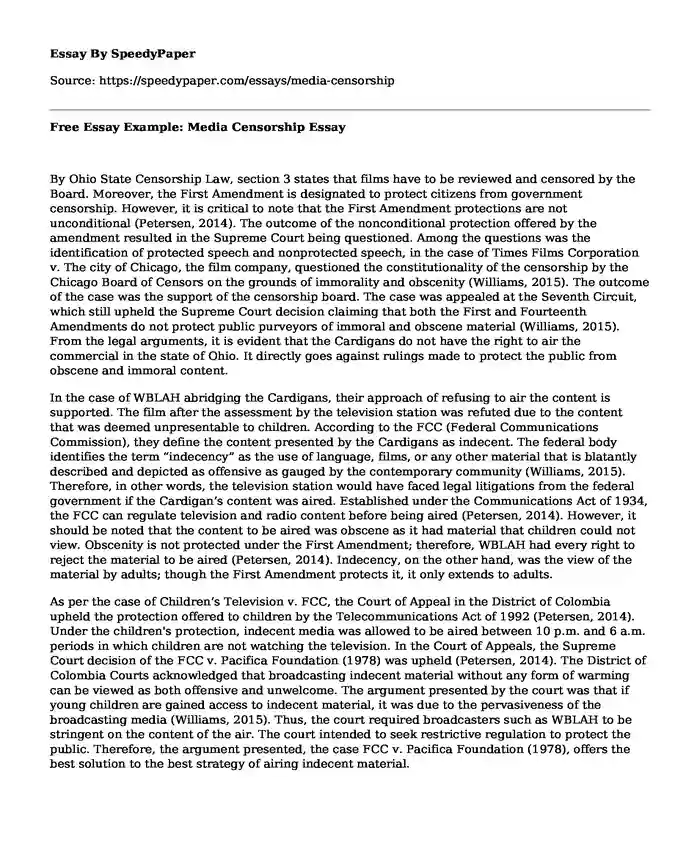
| Type of paper: | Essay |
| Categories: | Censorship Court system Media Essays by pagecount |
| Pages: | 3 |
| Wordcount: | 605 words |
By Ohio State Censorship Law, section 3 states that films have to be reviewed and censored by the Board. Moreover, the First Amendment is designated to protect citizens from government censorship. However, it is critical to note that the First Amendment protections are not unconditional (Petersen, 2014). The outcome of the nonconditional protection offered by the amendment resulted in the Supreme Court being questioned. Among the questions was the identification of protected speech and nonprotected speech, in the case of Times Films Corporation v. The city of Chicago, the film company, questioned the constitutionality of the censorship by the Chicago Board of Censors on the grounds of immorality and obscenity (Williams, 2015). The outcome of the case was the support of the censorship board. The case was appealed at the Seventh Circuit, which still upheld the Supreme Court decision claiming that both the First and Fourteenth Amendments do not protect public purveyors of immoral and obscene material (Williams, 2015). From the legal arguments, it is evident that the Cardigans do not have the right to air the commercial in the state of Ohio. It directly goes against rulings made to protect the public from obscene and immoral content.
In the case of WBLAH abridging the Cardigans, their approach of refusing to air the content is supported. The film after the assessment by the television station was refuted due to the content that was deemed unpresentable to children. According to the FCC (Federal Communications Commission), they define the content presented by the Cardigans as indecent. The federal body identifies the term “indecency” as the use of language, films, or any other material that is blatantly described and depicted as offensive as gauged by the contemporary community (Williams, 2015). Therefore, in other words, the television station would have faced legal litigations from the federal government if the Cardigan’s content was aired. Established under the Communications Act of 1934, the FCC can regulate television and radio content before being aired (Petersen, 2014). However, it should be noted that the content to be aired was obscene as it had material that children could not view. Obscenity is not protected under the First Amendment; therefore, WBLAH had every right to reject the material to be aired (Petersen, 2014). Indecency, on the other hand, was the view of the material by adults; though the First Amendment protects it, it only extends to adults.
As per the case of Children’s Television v. FCC, the Court of Appeal in the District of Colombia upheld the protection offered to children by the Telecommunications Act of 1992 (Petersen, 2014). Under the children's protection, indecent media was allowed to be aired between 10 p.m. and 6 a.m. periods in which children are not watching the television. In the Court of Appeals, the Supreme Court decision of the FCC v. Pacifica Foundation (1978) was upheld (Petersen, 2014). The District of Colombia Courts acknowledged that broadcasting indecent material without any form of warming can be viewed as both offensive and unwelcome. The argument presented by the court was that if young children are gained access to indecent material, it was due to the pervasiveness of the broadcasting media (Williams, 2015). Thus, the court required broadcasters such as WBLAH to be stringent on the content of the air. The court intended to seek restrictive regulation to protect the public. Therefore, the argument presented, the case FCC v. Pacifica Foundation (1978), offers the best solution to the best strategy of airing indecent material.
References
Petersen, J. (2014). Can Moving Pictures Speak? Film, Speech, and Social Science in Early Twentieth-Century Law. Society For Cinema & Media Studies, 53(3), 76-99. Retrieved 13 June 2020, from https://www.jstor.org/stable/43653621.
Williams, B. (2015). Obscenity and film censorship. Cambridge University Press.
Cite this page
Free Essay Example: Media Censorship. (2023, Aug 28). Retrieved from https://speedypaper.net/essays/media-censorship
Request Removal
If you are the original author of this essay and no longer wish to have it published on the SpeedyPaper website, please click below to request its removal:
- PhD Personal Statement, Free Essay Sample
- The Homeless In Geauga County. Free Essay on Raising Funds
- Packshots Research Essay Example
- How Children Demonstrate Trauma, Essay Sample in Psychology
- Essay Sample on Media Convergence
- Essay Sample: Nursing Theory Selected As a Guide for Practicum Experience
- Paper Example. The North Coast Masks
Popular categories




